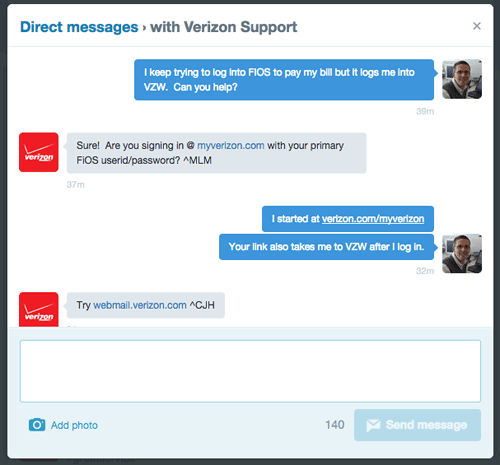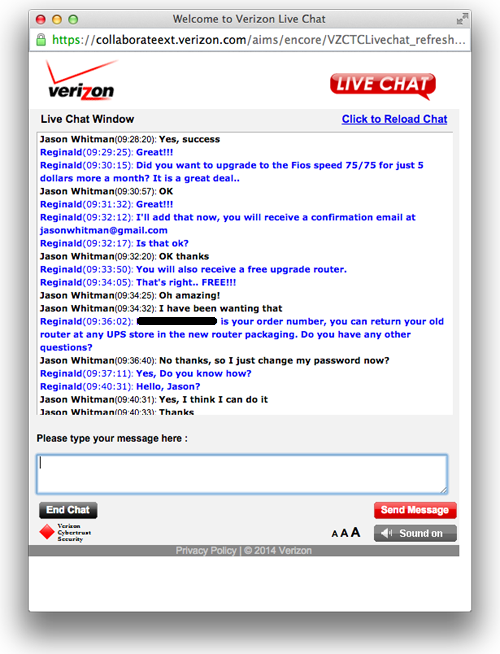I recently was locked out of my Verizon FIOS account. Any time I tried to log in, I ended up in my Verizon Wireless account instead (I am a client of both). I naturally took to Twitter to see if I could get help, and the results were impressive. Inspired by my colleague’s recent post on the connection between service and brand, I wanted to share how well Verizon handled my situation.
I started by following @VerizonSupport, and posted a tweet documenting my situation. I didn’t expect a quick response, but got one fast:
@jasonwhitman We're here to help with this. Please follow and DM us so that we can get started working on this for you.^JXJ
— Verizon Support (@VerizonSupport) September 28, 2014
As Verizon recommended, I later started a conversation with a support rep via Twitter direct message. Again, I didn’t expect an immediate reply, but the exchange happened so quickly that it almost seemed like live chat. Every time I checked my direct messages, I had a response from a Verizon rep.

Unfortunately, the problem couldn’t be solved via Twitter alone, but the Verizon rep had a solution – to kick off a secure live chat so I could share more sensitive information like my username and pin number. There, Reginald reset my password, confirmed I could log in successfully, then… tried an upsell!

Now, this was a bold move. You could question whether it was totally necessary. You could ask whether it was truly in the spirit of helping me. But I was receptive to it because the process had gone so well. The outstanding service not only solved my problem, but gave me such a positive brand perception that I was ready to buy. Also, knowing that Reginald likely is paid or bonused on these upsells, I really wanted to reward his great service.
What I liked about this experience:
- Service is speed. I like how quickly Verizon responded to all of my inquiries. There never was a note that I would get a response in 24-48 hours. I always got a response quickly. If anything, I was the one who was slow to respond to a tweet or chat message. Note that they had at least two reps staffing the @VerizonSupport Twitter account but the flow was seamless.
- Verizon respected my way of communicating. I kicked off the response on Twitter, and at no point did the reps ask me to call a 1-800 number. I love this and can’t say enough how important this is to me. It shows a real commitment to social service – the Twitter account is not just a fake front end for phone service. When they asked me to move to live chat, it was for security reasons (or so they convinced me), so I was receptive. It also was easy – I just clicked a link and went from tweeting with JXJ, MLM and CJH to chatting with Reginald.
- I felt better off than before. This is critical in any service reaction – do I feel like I came out ahead when I was done? This is heavy perception, because Verizon just upsold me (which they had been trying to do with direct mail, e-mail and TV pop-ups unsuccessfully), right? But for me, my problem was solved, I got faster FIOS for $5 per month and a free router. I felt better than when I started.
What I learned from this experience:
- Service can deliver revenue. I know this from my own teams, but experiencing it myself is always enlightening. When Reginald went for the upsell, I recognized it as such but I didn’t hesitate to say yes. I do the same when Enterprise provides great service at the airport. When this works, it’s a natural payoff of the service interaction. When it doesn’t, it can crash hard. A sales pitch works better when done inside a positive service experience.
- Verizon is staffed for true social service. They had multiple reps handling the Twitter account, knew how to seamlessly push me to live chat, and never asked me questions about my account that suggested ineptitude or lack of training. They also never tried to push me to the phone team.
- In-app resolution is so important. When I was chatting with Reginald, if he would have told me to check my e-mail for a password reset link, I likely would have bailed (and he would have never gotten to the upsell). Instead, he reset my password for me and waited while I confirmed it worked. The more you can help the client in the current interaction you have, the more likely you are to solve the problem and deliver a positive experience.
